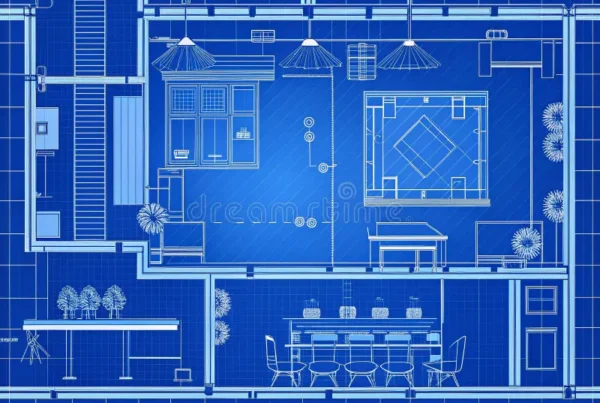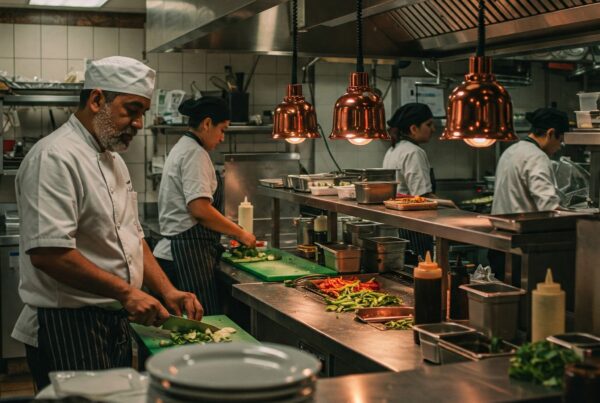Walking into a restaurant is more than just entering a place to eat—it’s entering an experience. From the first step inside, guests engage their senses: sight, sound, smell, even touch. If the environment feels off—harsh lighting, noisy chatter, or uncomfortable seating—it can negatively affect their mood and appetite before dessert even arrives. In a world where dining has evolved beyond taste, the design of your restaurant plays a crucial role in telling your story, inviting guests in, and elevating your food to legendary status. Here’s how to craft a restaurant space that truly resonates with your flavors.
Understanding Atmosphere as a Sensory Prelude
Every element in your restaurant contributes to the ambiance—the unwritten mood that frames the moment your guests arrive. Think of it as the first line of a novel: it sets the tone and hints at what’s inside. If you’re serving wood-fired, smoky dishes with a family-style focus, warm hues, rustic textures, and soft acoustics sell that narrative before people look at the menu. Leather booths, Edison bulbs, exposed brick—these details all tell a story.
Or maybe your cuisine leans modern and clean—farm-to-table salads or artfully plated entrees. Consider a more minimal setting: sleek tabletops, brushed-metal accents, open space. Add natural light, neutral tones, and plants to bring a calm harmony that complements light, fresh cuisine. For a high-energy bar with bold flavors, consider more vibrant finishes: neon art, upbeat music, punchy color palettes. The design should echo the food’s personality—a visual and physical overture to what’s coming.
Harmonizing the Floor Plan for Flow and Functionality
Aged dining rooms may feel cluttered or cramped, creating hidden traffic jams for servers and guests. A well-designed layout, on the other hand, makes hospitality feel effortless. When planning your floor plan, visualize people walking—guests arriving, servers delivering food, cooks exiting the kitchen. Every step matters.
Clear guest flow begins at the entry. Guests should immediately find the host stand without being overwhelmed by tables or décor. Pathways should be spacious enough for wheelchairs, strollers, and staff carrying dishes.
Server efficiency is just as critical. The restaurant should be wired around service stations. Ideally, servers should be able to access glasses, napkins, and smallware without crossing tables. Optimize kitchen access to reduce the distance between diners and their food.
Flexibility plays a key role too. A layout that accommodates singles, couples, and larger parties allows you to respond to varying guest groups. Consider movable partitions, benches, or varying table sizes that shift based on volume and demand, while maintaining visual cohesion. This kind of adaptability is the backstage efficiency that creates front-of-house magic.
Lighting: The Invisible Flavor
If color is the soul, lighting is the emotion. Lighting can elevate a dish into something cinematic or reduce it to an afterthought. Warm light enhances rich tomato sauces, caramel tones, and aged cheeses. Cooler light can elevate a ceviche or salad, giving it a crisp, fresh presence. Harsh fluorescent bulbs? They should disappear from your vocabulary.
Instead, layer your light. Ambient light provides general illumination—use dimmers here to adapt from daytime to evening vibes. Task lighting zeroes in on where it matters—above prep counters, over the bar, or landing neatly on each table. Accent lighting draws attention to art, architecture, or a dramatic presentation wall. It adds depth and sophistication.
Dimmers are critical. Running bright morning light into a nighttime dimmed space leaves a stronger impression than simply flipping a switch. Light is as much a branding tool as typography or logo. Use it intentionally to weave all aspects of your restaurant design together.
The Comfort Equation: Seating, Space, and Acoustics
Comfort isn’t luxury—it’s essential. If people feel physically at ease, they stay longer, relax more, and spend more. Good seating starts with ergonomics: chairs should provide back support without digging into the spine, and bench cushions should be firm but forgiving. That matters when guests linger over courses or wine.
Think through spatial comfort, too. A crowded layout communicates urgency and pressure; spacious layouts convey leisure and welcome. Leave enough elbow room between tables so that guests and servers can move gracefully. Create purposeful spacing—groups shouldn’t feel like they’re eavesdropping on strangers.
Finally, consider acoustics. Clear conversation is a pleasure today—auditory fatigue is not. Hard, reflective surfaces breed loudness. Fabrics like curtains or upholstered panels absorb noise. Include wall coverings or overhead panels shaped to break up sound. A restaurant should buzz pleasantly without shouting—a comfortable hum, not a hectic roar.
Materials & Textures: Tactile Storytelling
Your restaurant’s personality lives in material choices. Wood suggests warmth and tradition. Polished concrete speaks of modernity and grit. Metal accents hint at industry, urbanity, or minimalist design. Rattan and woven textures evoke beachside ease or artisan craftsmanship.
Graphics and signage are part of that material design, too. A chalkboard menu suggests casual and fresh. A laser-cut metal sign speaks to intention and investment. Even wallpaper patterns or tile designs become brushstrokes in your overall atmosphere.
Pro tip: consider how materials age. A butcher block table will accumulate rich patina—great for rustic credibility. A stainless-steel countertop in a fine dining space stays impeccably gleaming. Treat wear as part of your design story—that lived-in quality can feel authentic, not neglected.
Scent & Sound: Invisible Enhancers
Guests may not notice an expertly chosen scent or a curated playlist, but they’ll remember how it made them feel. Scent creates an instant memory. A subtle aroma of fresh bread, citrus, or floral herbs can make an atmosphere feel more vivid and appetizing.
Approach scent like a perfume—not overpowering, but evidence of attention. It should complement your menu, not disguise it. Conversations can be lost in a din of bad acoustics, so consider how loud your space really is. A playlist that sets the right tone can create an emotional anchor for your guests.
Music sets tempo: ambient jazz encourages leisurely enjoyment, while upbeat funk might promote a lively bar vibe. Avoid generic top-40 playlists or track loops—they work against authenticity. Use curated playlists that reflect your brand’s heart and reinforce the narrative you’ve built with every design choice.
Finishing Touches: Curating Details That Delight
It’s often the little things that surprise and delight—and become conversation pieces. These details bridge the gap between a passable dining space and a memorable, brand-led destination.
Branded tableware like ceramic mugs or napkins hint at confidence. Statement wall art—be it local photographer’s prints or commissioned murals—reinforces your aesthetic. Bathroom styling—coordinated towels, soap dispensers, even wallpaper—signals you care about every corner of the guest journey.
Think about the elements guests interact with: menus, check presentations, takeout bags. These are your silent storytellers. A menu printed on heavy card stock conveys care; one on low-quality paper does not. Tailor these touchpoints to align with your narrative, and you create a cohesive, resonant experience that lingers after the meal is done.
Outdoor Space: The First Impression (and Grand Finale)
If you have a patio, sidewalk seats, or a front door visible from the street—those are the first interactions a potential guest has with your brand. Greenery, signage, quality lighting, and even outside music frame those interactions. After the meal, outdoor space is the final taste of your hospitality.
Use umbrellas, heaters, fans, or greenery to protect guests from heat or glare, not just with practicality, but with style. A well-lit sidewalk dining area can draw evening diners. Outdoor seating creates a sense of inclusivity—open to passersby, warm and inviting. When crafted with intention, it becomes an open-air extension of your brand and an active part of your restaurant’s identity.
Designing for Sustainability (and Storytelling)
Eco-conscious design is rapidly becoming synonymous with quality. Choosing sustainable materials—reclaimed wood, recycled metal, low-VOC paint, LED lighting—not only reduces your footprint; it gives guests a reason to respect and root for your space. It becomes a layer of storytelling: you aren’t just selling flavor—you’re selling values.
Visible sustainable design—like a wall of reclaimed wood or a plant-wall—shows that you’re serious about care for people and planet. Include simple statements on your menu or wall displays that highlight these efforts. People today prefer restaurants that reflect their own environmental concerns. Designed well, sustainability doesn’t just save resources, it boosts brand perception.
Testing Your Design with Real-Time Feedback
Your restaurant will teach you as much about its design as you teach it. Invite feedback early—open in soft launch or hold a friends-and-family preview night. Observe guests: Are they drawn to certain seats? Do they lean in when talking or sip too fast? Do they linger after the meal, or are they ready to leave? Your guests are living data for how your space and experience work in real usage.
Take notes during those preview events. Ask guests how they felt about light levels, music volume, chair comfort, table spacing, and bathroom experience. Their observations can prompt simple, high-impact tweaks—like adding a lamp in a dark corner, swapping out a cushion, or rearranging a server station.
The Sum of Its Parts: Design as Identity and Experience
Every decision—from wood finish to HVAC noise—contributes to the dining experience. The most successful restaurants are those where food, service, and design are not separate areas, but woven together. A restaurant may open with a strong concept, but it’s architecture, materials, lighting, sound, and service that bring that concept to life. With intention, you can create a space that doesn’t just serve food, but tells a story, evokes emotion, and becomes a beloved meeting point for your community.
A well-designed restaurant is more than beautiful—it’s memorable, intuitive to use, and emotionally resonant. When your space feels as good as it tastes, your customers won’t just eat—they’ll stay, talk, smile, share, and come back again. And that’s how great restaurants are born.



